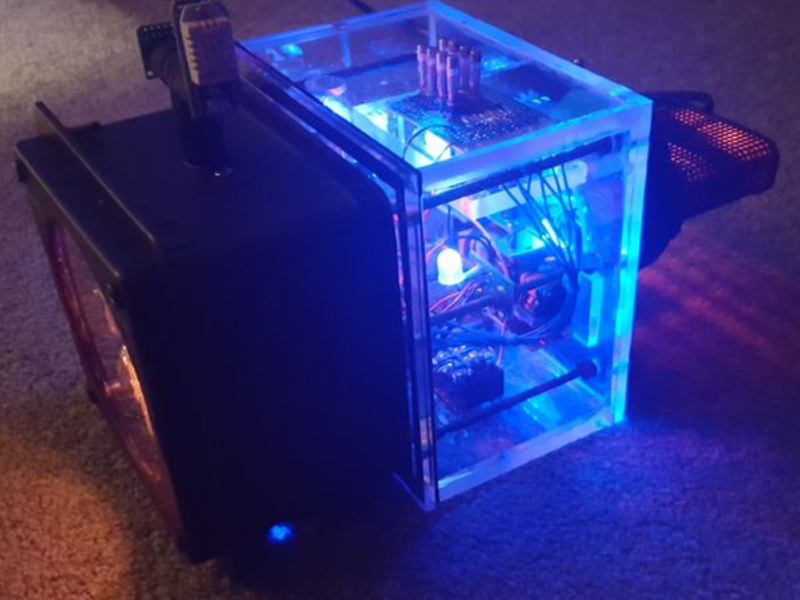The Synchroscope is an interesting power plant instrument which doubles up as two devices in one. If the generator frequency is not matched with the grid frequency, the rotation direction of the synchroscope pointer indicates if the frequency (generator speed) needs to be increased or decreased. When it stops rotating, the pointer angle indicates the phase difference between the generator and the grid. When [badjer1] [Chris Muncy] got his hands on an old synchroscope which had seen better days at a nuclear power plant control room, he decided to use it as the enclosure for a long-pending plan to build a Nixie Tube project. The result — an Arduino Nixie Clock and Weather Station — is a retro-modern looking instrument which indicates time, temperature, pressure and humidity and the synchroscope pointer now indicates atmospheric pressure.
Rather than replicating existing designs, he decided to build his project from scratch, learning new techniques and tricks while improving his design as he progressed. [badjer1] is a Fortran old-timer, so kudos to him for taking a plunge into the Arduino ecosystem. Other than the funky enclosure, most of the electronics are assembled from off-the-shelf modules. The synchroscope was not large enough to accommodate the electronics, so [badjer1] had to split it into two halves, and add a clear acrylic box in the middle to house it all. He stuck in a few LEDs inside the enclosure for added visual effect. Probably his biggest challenge, other than the mechanical assembly, was making sure he got the cutouts for the Nixie tubes on the display panel right. One wrong move and he would have ended up with a piece of aluminum junk and a missing face panel.
Being new to Arduino, he was careful with breaking up his code into manageable chunks, and peppering it with lots of comments, for his own, and everyone else’s, benefit. The electronics and hardware assembly are also equally well detailed, should anyone else want to attempt to replicate his build. There is still room for improvement, especially with the sensor mounting, but for now, [badjer1] seems pretty happy with the result. Check out the demo video after the break.
Thanks for the tip, [Chris Muncy].
















If the first digit is not lit… is it working? Zero! OK. Youl’d want that in a nuke plant, right?
That aside I was expecting a giant dial like a strobe tuner. A plant operator at the control keeping the light at the precise phase +/- 5 degrees, just like in Metropolis. Easy on the rods, pull out just a little. Instead it’s a steampunk version of a clip-on +/- indicator guitar tuner. OK. Good nothing ever fried.
I have seen a few phase upsets usually lasting less than a couple of seconds. Years ago our piano tuners knew that the reference based on 60 Hz built into the old strobe tuners weren’t good in a couple of counties north of here, they were on their own grid. About an hour south of Chicago in the 60-70’s.
As much as I would love to take credit for this project, please change the builder’s name to badjer1, the actual project owner. :-)
whoops! Thanks for pointing out the error, Chris. Fixed.
So the meter movement does absolutely *nothing* !?? What’s the point ? Why not just use any old analog meter ? Heck pulling one out of a locomotive to appeal to foamers (a pejorative for railroad buffs) would be just as good. Or perhaps an altimeter or AHI for the aviation buffs. And a synchroscope is seen at both nuke and non-nuke generating stations.
It came from a nuclear powerplant it glows blue. Sweet!
Shouldn’t it glow green?
No. Extremely potent sources of radiation glow blue due to the Cherenkov effect.
https://en.m.wikipedia.org/wiki/Cherenkov_radiation
Only tweak I’d suggest is have the needle indicate whether the air pressure was rising or falling as that is often more interesting than the absolute value (or even the distance from annual average).
That’s really nice.
Having been there and done that over 30 years ago the way you used it was pretty simple. You wanted the generator you werd bringing on line to be slighly faster than the bus you were connecting to. That meant the generator immediately picked up so of the load and would slow slightly and match frequency when you clised the breaker. So, dial spinning slowly clockwise and just before the needle hit zero, close the breaker. The slight delay in the breaker closing is why jys before zero to minimize the phase difference.
The sync dial was done at that point and you used other meters to control the generator load.
Ole Navy Nuc
the ‘nuclear synchronizer” is old meter for synchronizing an electrical generator ( steam/gas turbine/diesel – nuclear is just the heat source for a steam turbine) to the electrical grid; operator would know to close the circuit breaker to make the connection when the needle was at top dead centre….. :-)